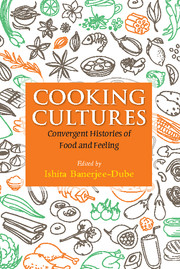Book contents
- Frontmatter
- Contents
- Acknowledgements
- Introduction: Culinary Cultures and Convergent Histories
- Part I Food, Pride, Power
- Part II Cooking, Cuisine, Gender
- Part III Food, Identity, Personhood
- 7 Local Foods and Meanings in Contemporary China: The Case of Southwest Hubei
- 8 From the Market to the Kitchen and Table: Food and its Many Meanings in Dakar
- 9 What is Human?: Anthropomorphic Anthropophagy in Northwest Mozambique
- Part IV Food, Myth, Nostalgia
- Contributors
- Index
- References
7 - Local Foods and Meanings in Contemporary China: The Case of Southwest Hubei
from Part III - Food, Identity, Personhood
Published online by Cambridge University Press: 05 July 2016
- Frontmatter
- Contents
- Acknowledgements
- Introduction: Culinary Cultures and Convergent Histories
- Part I Food, Pride, Power
- Part II Cooking, Cuisine, Gender
- Part III Food, Identity, Personhood
- 7 Local Foods and Meanings in Contemporary China: The Case of Southwest Hubei
- 8 From the Market to the Kitchen and Table: Food and its Many Meanings in Dakar
- 9 What is Human?: Anthropomorphic Anthropophagy in Northwest Mozambique
- Part IV Food, Myth, Nostalgia
- Contributors
- Index
- References
Summary
Local foods have been widely discussed by scholars from the perspectives of anthropology (Finnis, 2012; Etkin, 2009; Etkin, 1994; Freeman, 1996, 45–53; Wilk, 1999, 244–55), ecological conservation (Nabhan, 2001, 2008, 2009), ethno-botany (Pardo-de-Santayana, et al., 2010; Balick and Cox, 1996), women's studies (Howard, 2003), and political history (Scott, 2009; Bergman, 1985, 106–32). Anthropology has also been interested in the meanings and marketing of marginal or ethnic local food in remote areas (Finnis, 2012). Following upon such a lead, I discuss the many meanings and strategies of marketing of local food by marginalised ethnic minorities in China.
Local foods in ethnic areas are meaningful and multifunctional at the local, national and even global levels. Anthropologists have noticed that there are generally two ways for people to deal with the meanings of marginal/ethnic food: either to highlight or to hide the ethnic ties/affiliations of food. The first way has been mainly used for political ends, such as to set up a connection or establishing an identity with certain ethnic groups by eating their distinctive or representative foods (i.e., snonggi, the sago flour in Indonesia) (Utari, 2012, 49–66). The second has occurred in the marketing of ethnic foods to mainstream consumers, as demonstrated in case studies of avocado in the US (Charles, 2002, 131–55), alpaca meat in Peru (Markowitz, 2012, 34–48), and minor millets in India (Finnis, 2012a, 109–32). This study provides a case in which the local food items in ethnic areas are marketed with their ethnic affiliations.
Studies have shown that the symbolic meanings associated with ethnic foods matter, and as Finnis said, ‘the success of an attempt to take a marginal food into wider contexts may therefore depend on whether its symbolic status is effectively repositioned’ (Finnis, 2012, 9). Hiding the ethnic associations of foods has been one of the key strategies used in such repositioning, as in the cases of avocado, minor millet and alpaca meat in the US, India and Peru respectively.
As existing studies have shown, a number of things need to be done in order to market marginal foods, including setting up organisations, reimagining or reinterpreting the foods, repackaging or standardisation of the foods and cuisines, arranging ritualistic events, and promoting repetitive mass discourses.
- Type
- Chapter
- Information
- Cooking CulturesConvergent Histories of Food and Feeling, pp. 139 - 157Publisher: Cambridge University PressPrint publication year: 2016
References
- 2
- Cited by



